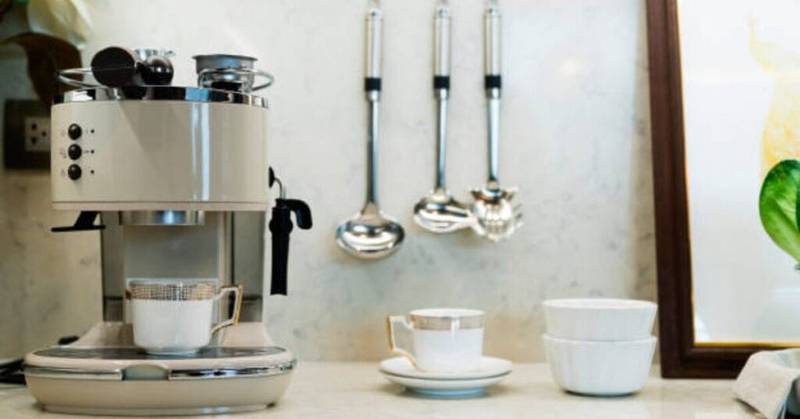Espresso machines are essential for coffee enthusiasts, producing rich, concentrated shots. These versatile machines can also craft perfect lattes when used with the right tools and techniques. This guide explores how to maximize your espresso machine’s potential, offering tips to create café-quality lattes at home or in a café.
As an affiliate site, we are associated with the amazon. We might receive a commission when you use links or recommendations on our website to make qualified purchases. The cost you pay for the goods or services is unaffected by this.
Table of Contents
What is a Latte?

A latte, short for “caffè latte,” is an Italian coffee drink made with espresso and steamed milk. The standard ratio is one part espresso to three parts steamed milk, topped with a small layer of milk foam.
The latte’s creamy texture and balanced flavor profile make it a popular choice among coffee enthusiasts. It can be enjoyed plain or with various flavorings such as vanilla, caramel, or hazelnut.
The Role of the Espresso Machine in Latte Making
The foundation of latte making is the espresso machine. The foundation of the latte is extracted from it, which is referred to as espresso. For making the famous creamy texture of the latte, the machine also has a steam wand for frothing milk.
Essential Features of an Espresso Machine
To create a latte, your espresso machine needs to have specific features:
- Steam Wand: This is crucial for frothing and steaming milk to achieve the right texture and temperature.
- Pressure: The machine should produce at least 9 bars of pressure to extract a quality shot of espresso.
- Temperature Control: Consistent temperature is vital for both the espresso extraction and milk steaming processes.
Types of Espresso Machines
There are several types of espresso machines suitable for making lattes:
- Manual Espresso Machines: These require more skill and effort but offer greater control over the brewing process.
- Semi-Automatic Espresso Machines: Strike a balance between control and convenience, allowing users to manage the extraction time and milk steaming.
- Automatic Espresso Machines: Automate much of the process, ideal for beginners or those seeking convenience.
- Super-Automatic Espresso Machines: Offer a high level of automation, from grinding beans to frothing milk, perfect for those who want a hassle-free experience.
Step-by-Step Guide to Espresso Machine Make Latte

Make a strong espresso shot. Milk is heated to the steaming point. Using the steam wand, you can make microfoam. Combine frothed milk and espresso in a latte glass. Add the foam amount you want for the taste you want. For a finishing touch, garnish with cocoa powder or cinnamon.
1. Preparing the Espresso
Selecting the Coffee Beans
Choose high-quality coffee beans. Freshly roasted beans with a medium to dark roast profile are ideal for lattes.
Grinding the Coffee
Grind the beans to a fine consistency. A burr grinder is recommended for uniform grind size.
Tamping the Grounds
Distribute the coffee grounds evenly in the portafilter and tamp them firmly to ensure even extraction.
Pulling the Espresso Shot
Insert the portafilter into the machine and start the extraction process. Aim for a shot that takes about 25-30 seconds, producing around 1 ounce of espresso.
2. Steaming the Milk
Choosing the Milk
Whole milk is preferred for its rich texture, but you can also use alternatives like almond, soy, or oat milk.
Frothing Technique
Submerge the steam wand just below the surface of the milk and turn it on. Create a whirlpool effect by positioning the wand at an angle. Once the milk reaches about 150°F (65°C), turn off the steam and remove the wand.
Achieving the Right Texture
Aim for a silky microfoam with small bubbles. The milk should have a glossy appearance and a creamy consistency.
3. Combining Espresso and Steamed Milk
Pour the steamed milk into the espresso, starting with the milk at a higher position to mix thoroughly, then lowering the pour to create latte art if desired. The result should be a well-blended latte with a smooth layer of microfoam on top.
Enhancing Your Latte Experience
Experimenting with flavors can elevate your latte experience. Add a shot of vanilla syrup or caramel. Explore various milk alternatives, such as almonds or oats. For a novel twist, try powders or flavored syrups. Your latte art is perfect for a visually appealing touch.
Flavoring Your Latte
Add syrups like vanilla, caramel, or hazelnut to personalize your latte. Simply add the syrup to the espresso before pouring in the steamed milk.
Latte Art Basics
Latte art adds a visual appeal to your coffee. Start with simple designs like hearts or leaves and practice to improve your skills. The key is to control the milk pour and the movement of the cup.
Cleaning and Maintenance
Regularly clean your espresso machine, especially the steam wand, to prevent milk residue build-up. Descale the machine periodically to maintain its performance.
Read More Guides
- Can you use a Coffee Machine without a filter: Out of Filters? No sweat! The secret to Filter-free Coffee
- Are Flavoured Coffee Beans bad for you: The dirty truth about Flavored Coffee Beans: Friend or Foe?
- How to Flavor Coffee without adding Calories: Crafting Calorie-Free Coffee Delights
- How to make Pecan Flavored Coffee: Complete Step-by-Step Guide
- Is Espresso Ground Coffee the Same as Espresso: Difference Between Espresso and Coffee
FAQs || For Espresso Machine Make Latte
Can I make a latte with an espresso machine?
Most espresso machines with a steam wand can make a latte. However, machines with better pressure and temperature control will yield superior results.
What type of milk is best for lattes?
Whole milk is typically best due to its fat content, which creates a creamy texture. Non-dairy alternatives like almond, soy, or oat milk can also be used, though they may produce different textures and flavors.
How can I improve my latte art skills?
Practice is key. Start with simple designs and gradually try more complex patterns. Watching tutorials and attending barista workshops can also help.
Do I need a special grinder for espresso?
A burr grinder is recommended for its ability to produce a consistent grind size, which is crucial for espresso.
How often should I clean my espresso machine?
Clean the steam wand after every use and perform a thorough cleaning of the machine at least once a week. Descaling should be done every few months, depending on usage.
Conclusion
Espresso Machine make latte is both an art and a science. By understanding the essential features of your machine, mastering the techniques of espresso extraction and milk steaming, and incorporating your personal touches, you can create a delicious and visually appealing latte at home.
Whether you are a beginner or an experienced barista, this guide provides valuable insights to enhance your coffee-making journey. Enjoy experimenting with flavors and perfecting your latte art, and most importantly, savor the rich and creamy delight of a well-made latte.







